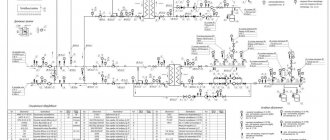Who doesn't dream of finding a treasure at least once in their life? And few people suspect that precious resources are right under our feet. We own the greatest wealth - geothermal energy.
Have you ever seen a geyser?
Not really
Geothermal energy is heat coming from the earth and is a natural, renewable resource for producing electricity. The Earth's heat is inexhaustible in volume; it exceeds all energy resources combined millions of times.
Even 1% of the Earth's energy replaces hundreds of power plants. All that remains is to learn how to use it.
Geothermal energy is one of the most promising in the world.
Characteristics of the Earth's heat reserves
Characteristics of reserves Numerical value
| Energy released when the core cools by 1 degree Celsius | 2*10^20 kWh |
| Core temperature | 6000 degrees Celsius |
| Core cooling rate | 300-500 degrees Celsius in a billion years |
| Heat flow | 47 Terawatt |
| Thermal power of the Earth | 33 Terawatt |
| Heat flux density | less than 0.1 Watt/m2 |
Even one percent of this power is equivalent to more than one hundred power plants. But the low heat flux density makes it difficult to collect and process this energy.
Calculations
The main parameters that are taken into account in any calculations are:
- temperature (depths from 15-20 m or more warm up from 8 to 100 degrees, depending on the conditions);
- extracted power value (average value - 0.05 kW per 1 m);
- the influence of climate, humidity and contact with groundwater on heat transfer.
Interesting Sugar production waste: bagasse, molasses, filter cake
What is very interesting is that completely dry rocks emit no more than 25 W per 1 m2, and if there is groundwater, this figure rises to 100-110 W. We must not forget that the standard operating time of a heat pump is 1800 hours per year. If you exceed this figure, the system will not become more efficient, but its wear will rapidly increase. What is much worse, excessive exploitation of the thermal resource of the subsoil leads to its cooling and even to the freezing of rocks at the working depth. Following this, the soil may subsidence, sometimes damaging working pipes and above-ground structures.
Classification of geothermal energy
The main source of geothermal energy is the heat flow of the planet’s interior, which is directed towards the surface. This heat is generated through chemical reactions, radioactive decay, and nuclear friction. Geothermal heat can be obtained in various ways.
Types of resources used
The following types of resources are used to extract geothermal energy:
- the heat of the planet's surface up to hundreds of meters to the core;
- hydrothermal (natural reservoirs with water) and steam-hydrothermal (places where steam and a mixture of water vapor appears) systems;
- energy from dry rock (petrothermal);
- magma.
Hydrothermal energy
This type of energy is aimed at producing electricity from the heat of groundwater. Heat sources are as follows:
- water - for existence, a layer of rock is needed to transfer heat, while the pressure is higher than atmospheric;
- steam-water - there is water between two layers, heat is transferred through the lower layer, and the upper layer does not allow water to seep out; to obtain heat, you need to release water or steam, for this you need to drill a well;
- steam — the operating scheme is similar to the previous one, but only steam transfers heat.
Petrothermal energy
This type of energy produces electricity through underground heat from hot rock. However, this type of energy is less common: to produce energy, heated rock is required, which, even in areas with high temperatures, lies at a depth of at least two kilometers.
Methods for extracting resources
To obtain energy, one of the following methods is used:
- traditional ; fountain - due to pressure in the ground, the resource self-flows;
- pumping - the method is used when the formation of a fountain is impossible;
Main applications of energy
Geothermal energy is being used more and more widely, although it is not key to the entire energy sector. Due to the specific nature of extraction, geothermal energy is used in the following cases.
Industrial use
Industry is an area that needs an energy source that will not depend on external factors, such as the time of day. Geothermal energy can provide this, so industry is one of the main consumers of this type of energy. Large-scale mining is carried out in Iceland, New Zealand, Russia, the United States of America and so on.
Application in agriculture
On the farm, geothermal energy can be used to heat plants in a greenhouse or greenhouse, to water crops, as well as to provide heating for complexes responsible for keeping animals and birds. However, operation also depends on the composition of the water. The use of this type of energy in agriculture is observed in Greece, Mexico, Kenya, Israel, and Guatemala.
For heating houses
You can extract geothermal energy in small quantities yourself and organize it as centralized or private heating. For example, in private homes such systems operate autonomously.
The operating principle is similar to that of an air conditioner configured to heat the room. But the air conditioner stops working if the temperature outside is below 5 degrees Celsius, but this is not an obstacle to the geothermal system.
Collectors need to be installed in the depths; antifreeze will flow through them, absorbing heat and returning it to the heated room. The costs are only installation and the equipment itself.
Private sector
One of the most promising areas is the private sector, for which geothermal energy is a real alternative to autonomous gas heating. The most serious obstacle here is the high initial cost of the equipment, which is quite cheap to operate, which is significantly higher than the price of installing “traditional” heating.
MuoviTech, Geodynamics Ltd, Vaillant, Viessmann, Nibe offer their developments for the private sector.
Geothermal power plants
The deeper the borehole, the higher the temperature. However, in seismically dangerous zones, the temperature when immersed in a well rises faster due to the rupture of tectonic plates. A high geothermal gradient reduces the cost of energy production, since you have to drill less deeply. The best option is geysers, in which the water on the surface already reaches the required temperature.
Device and design
The power plant diagram can be imagined as follows: water is pumped into the bowels of the Earth, the liquid, seeping into cracks, is heated until water vapor appears, and then rises through a second well located in parallel.
The heated water is delivered to the station, the energy is converted into electricity using a generator and turbines.
According to their design, these power plants are:
- in steam hydrotherms - water heated in nature is used to extract energy;
- double-circuit water steam - a special steam generator creates additional steam.
Principle of operation
Geothermal energy uses several methods of operation.
- Direct method. For this method, dry steam is taken, which enters through a turbine;
- Indirect method. The method involves working with water vapor at temperatures above 180 degrees Celsius. The pressure caused causes water to flow through the well, and its subsequent reduction leads to the formation of steam in the turbine. The remaining water resource flows back into the well;
- Binary (mixed) method. Water is used with an additional liquid, for example, refrigerant.
Popularity in Asia
Currently, geothermal energy is literally undergoing a rebirth in China. The industry has been abandoned in this country for forty years. Interest in it was renewed with the coming to power of the country's leader Xi Jinping. Thanks to the efforts of the Secretary General, the city of Xianyang can rightfully be considered the world capital of green energy. In the country as a whole, during the three years of Jinping's rule, the volume of geothermal energy production increased from 28 to 100 MW.
The industry development plan was included in the 13th Five-Year Plan program. To a large extent, the dynamic development of this area is facilitated by engineers from Iceland invited to work in China. According to preliminary calculations, the geothermal potential in China is comparable to the energy that can be obtained by burning 853 billion tons of coal.
It is with the overconsumption of the latter that attempts to find alternative resources are associated, since 66% of the energy received in the country is generated using coal. The geothermal strategy is expected to be implemented in a maximum of 10 years. Already, China accounts for 15% of global geothermal energy production. The PRC plans to achieve a generation volume of 2 GW.
The share of geothermal energy in Japan reaches 21%. However, its development is actively hampered by environmental social movements due to the fact that the use of geothermal sources leads to an increase in the threat of environmental pollution. However, we will dwell on the dangers of geothermal energy below.
Foreign experts believe that the industry has great prospects in Kazakhstan. In a number of regions of the country, the temperature of groundwater reaches the boiling point, which, along with the rising cost of traditional electricity, makes geotherms an attractive investment. Graham Norman, a professor at the University of Michigan who visited the republic, believes that Kazakhstan’s potential is no worse than Turkey’s, where geothermal energy is developing outside areas with high intensity hot springs.
Large sources of energy resources
The main producer of geothermal heat is Iceland, which accounts for 30% of global energy. The Philippines comes in second place with 27% of the international value. Costa Rica and El Salvador produce 14 percent, ranking third. Kenya accounts for 11.2 percent and Nicaragua 10 percent.
In Russia, promising regions for geothermal energy production are the south and the Far East. In the south, any point in the region is suitable for exploring waters with a temperature range of 70-126 degrees Celsius.
For example, in Dagestan, 30% of the housing stock is provided with geothermal energy, although experts believe that the value can be raised to 70%. In the Chechen Republic, the ground was prepared for the extraction of heat, but the war temporarily interrupted work on this.
TOP 5 famous resorts with thermal waters
Hydrothermal springs, rich in beneficial minerals, are popular all over the world. The most famous are:
- Blue Lagoon (Iceland). It is a unique symbol of Iceland and is the leader in tourist visits - up to 300 thousand people a year. It is characterized by high temperatures, which in some places reaches 1000C. The thermal lake was formed on the site of a power plant that operated until 1999.
- Kusatsu Onsen (Japan). The healing properties of the hot spring were studied back in the century before last. Water coming from underground treats runny nose, poisoning, digestive system disorders, reduces blood pressure, normalizes sleep and calms the nervous system. The Japanese say that bathing in hot springs promotes longevity.
- Arenal (Costa Rica): Arenal is an active volcano area in central Costa Rica. The water in the source is distinguished by the fact that it does not have an unpleasant odor, contains a small amount of sulfates and is rainwater absorbed into the ground and heated there.
- Hot springs of Tyumen (Russia). There are many geothermal springs located in the Tyumen region. Many of them are equipped with swimming pools with fountains. The water has medicinal properties and is distinguished by a reddish tint.
- Lake Heviz (Hungary). The largest geothermal source in area - 4.7 hectares. There is a year-round resort on the shore, where vacationers from all over the world come to improve their health. Diseases of the musculoskeletal system, heart and blood vessels, and gynecological diseases are treated here. The lake has the peculiarity of being renewed every 28 hours, which helps maintain a constant water temperature.
Modern uses of geothermal energy
The total capacity of geothermal systems in the world is less than that of other renewable systems.
Despite this, geothermal energy is gaining great development, especially in areas where there is no fuel or it is expensive. Year World geothermal power capacity
| 1990s | 5 gigawatts |
| 2000s | 6 gigawatts |
| Late 2000s | 10.5 gigawatts |
In Russia
Russia currently has three operating power plants.
The Mutnovskaya geothermal power station has a capacity of 50 Megawatts, now 30%. To increase power, a 13 megawatt binary unit is installed.
The Verkhne-Mutnovskaya geothermal power plant has a capacity of 12 megawatts and a generation of 65 million kilowatt-hours. Works in conjunction with the previous power plant.
The Pauzhetskaya geothermal power plant also has 12 megawatts of power. Currently not put into operation.
In the world
The picture of modern use of geothermal heat looks like this:
- USA. The states stand out as the largest producer of geothermal heat. The most powerful group of stations is located between Sonoma and Lake and is called “Geysers”. Geothermal energy in the country receives state support;
- Philippines . In 2003, the power of the stations was 1930 Megawatts;
- Mexico . The installed capacity of this state is 953 megawatts. And Cerro Prieto produces 750 Megawatts;
- Italy . The total capacity at the beginning of the millennium for the country is 790 megawatts;
- Iceland . There are five combined heat and power plants operating in the country, one of which contains Reykjavik;
- Kenya . In 2005 the total capacity was 160 megawatts;
- Japan . According to the data of the last decade, there is information in the country that Japan is also trying to improve the environment through the introduction of alternative energy sources, although geothermal energy occupies a small share.
Prospects for the development of geothermal energy
0.5 percent (8.5 gigawatts) - this is how much geothermal energy now accounts for the rest of the world’s energy, although its power can reach 50% of the international energy sector. At a depth of three to five kilometers, energy was concentrated that could provide humanity with everything necessary for millennia. Every year the potential of geothermal resources grows by two to three percent.
In Russia, geothermal energy cannot become a leading industry, since the country's resource sources are not suitable for recognizing this type as the main one. However, development in this direction is a priority.
A little history
The idea of using the collected steam from geothermal sources was first expressed at the beginning of the 19th century by the French engineer and entrepreneur Francois de Larderel.
The world's first GeoPP in Larderello
Almost 100 years later, in 1904, Italian businessman Piero Conti tested a geothermal generator for the first time in the town of Larderello. There, seven years later, the world’s first geothermal power plant (GeoPP) was launched, which, by the way, is still operating today.
Piero Conti and his geothermal generator
Economic potential of geoenergy
Geothermal area, Iceland
The reserves that were explored by scientists at a depth of 3.5 kilometers at water temperatures from 40 degrees Celsius to 200 degrees are capable of producing 14 million cubic meters of hot water. This is equal to 30 million tons of standard fuel. Geothermal resource exceeds fuel resource by 10-15 times.
More than half of the territory of the Russian Federation has good potential for the development of geothermal electricity. The economic benefits of Geothermal energy are illustrated by an example: in Pauget, tariffs do not fluctuate, they are constant regardless of the weather and time of day.
Pros and cons of this energy source
Geothermal energy has two main advantages: inexhaustibility and independence from external factors. The installed capacity factor can reach up to 80 percent. However, the following disadvantages cannot be ignored:
- Economic importance of wells . To convert heat, it is necessary that the temperature value of the water be sufficient. To do this, wells are drilled deeper. But since the temperature gradient is most often small, you have to drill at least a kilometer in length, which is not economically profitable;
- Environmental friendliness . The exploitation of groundwater is problematic, since it contains compounds of toxic elements (metals and non-metals), so it cannot be thoughtlessly dumped on the surface; it must be pumped back. It is also important for maintaining aquifers;
- Provoking earthquakes . Activities for the extraction of electricity in a seismically hazardous area can lead to an earthquake. For example, like in Pohang in 2022.











